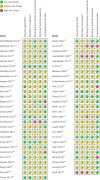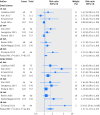Alpha blockers for treatment of ureteric stones: systematic review and meta-analysis
- PMID: 27908918
- PMCID: PMC5131734
- DOI: 10.1136/bmj.i6112
Alpha blockers for treatment of ureteric stones: systematic review and meta-analysis
Abstract
Objective: To investigate the efficacy and safety of alpha blockers in the treatment of patients with ureteric stones.
Design: Systematic review and meta-analysis.
Data sources: Cochrane Central Register of Controlled Trials, Web of Science, Embase, LILACS, and Medline databases and scientific meeting abstracts to July 2016.
Review methods: Randomized controlled trials of alpha blockers compared with placebo or control for treatment of ureteric stones were eligible. : Two team members independently extracted data from each included study. The primary outcome was the proportion of patients who passed their stone. Secondary outcomes were the time to passage; the number of pain episodes; and the proportions of patients who underwent surgery, required admission to hospital, and experienced an adverse event. Pooled risk ratios and 95% confidence intervals were calculated for the primary outcome with profile likelihood random effects models. Cochrane Collaboration's tool for assessing risk of bias and the GRADE approach were used to evaluate the quality of evidence and summarize conclusions.
Results: 55 randomized controlled trials were included. There was moderate quality evidence that alpha blockers facilitate passage of ureteric stones (risk ratio 1.49, 95% confidence interval 1.39 to 1.61). Based on a priori subgroup analysis, there seemed to be no benefit to treatment with alpha blocker among patients with smaller ureteric stones (1.19, 1.00 to 1.48). Patients with larger stones treated with an alpha blocker, however, had a 57% higher risk of stone passage compared with controls (1.57, 1.17 to 2.27). The effect of alpha blockers was independent of stone location (1.48 (1.05 to 2.10) for upper or middle stones; 1.49 (1.38 to 1.63) for lower stones). Compared with controls, patients who received alpha blockers had significantly shorter times to stone passage (mean difference -3.79 days, -4.45 to -3.14; moderate quality evidence), fewer episodes of pain (-0.74 episodes, -1.28 to -0.21; low quality evidence), lower risks of surgical intervention (risk ratio 0.44, 0.37 to 0.52; moderate quality evidence), and lower risks of admission to hospital (0.37, 0.22 to 0.64; moderate quality evidence). The risk of a serious adverse event was similar between treatment and control groups (1.49, 0.24 to 9.35; low quality evidence).
Conclusions: Alpha blockers seem efficacious in the treatment of patients with ureteric stones who are amenable to conservative management. The greatest benefit might be among those with larger stones. These results support current guideline recommendations advocating a role for alpha blockers in patients with ureteric stones.
Systematic review registration: PROSPERO registration No CRD42015024169.
Published by the BMJ Publishing Group Limited. For permission to use (where not already granted under a licence) please go to http://group.bmj.com/group/rights-licensing/permissions.
Conflict of interest statement
Competing interests: All authors have completed the ICMJE uniform disclosure form at http://www.icmje.org/coi_disclosure.pdf and declare: JMH received research grants from the Agency for Healthcare Research and Quality, the Urology Care Foundation, and Blue Cross Blue Shield of Michigan during the conduct of this study.
Figures





Comment in
-
Review: α-blockers increase passage of ureteric stones without increasing serious adverse events.Ann Intern Med. 2017 Mar 21;166(6):JC33. doi: 10.7326/ACPJC-2017-166-6-033. Ann Intern Med. 2017. PMID: 28320007 No abstract available.
-
Are α-Blockers Beneficial for Outpatient Management of Uncomplicated Ureteric Stones?Ann Emerg Med. 2018 Jan;71(1):138-140. doi: 10.1016/j.annemergmed.2017.04.001. Epub 2017 May 27. Ann Emerg Med. 2018. PMID: 28559040 No abstract available.
-
Tamsulosin and Distal Ureteral Stones-How Much Evidence is Enough? Exploring Value of Information in Urology.J Urol. 2019 Sep;202(3):465-466. doi: 10.1097/JU.0000000000000278. Epub 2019 Aug 8. J Urol. 2019. PMID: 31009296 No abstract available.
References
-
- Preminger GM, Tiselius HG, Assimos DG, et al. EAU/AUA Nephrolithiasis Guideline Panel. 2007 guideline for the management of ureteral calculi. J Urol 2007;178:2418-34. 10.1016/j.juro.2007.09.107 pmid:17993340. - DOI - PubMed
-
- Türk C, Petřík A, Sarica K, et al. EAU Guidelines on Diagnosis and Conservative Management of Urolithiasis. Eur Urol 2016;69:468-74. 10.1016/j.eururo.2015.07.040 pmid:26318710. - DOI - PubMed
-
- Hollingsworth JM, Rogers MA, Kaufman SR, et al. Medical therapy to facilitate urinary stone passage: a meta-analysis. Lancet 2006;368:1171-9. 10.1016/S0140-6736(06)69474-9 pmid:17011944. - DOI - PubMed
-
- Singh A, Alter HJ, Littlepage A. A systematic review of medical therapy to facilitate passage of ureteral calculi. Ann Emerg Med 2007;50:552-63. 10.1016/j.annemergmed.2007.05.015 pmid:17681643. - DOI - PubMed
-
- Lu Z, Dong Z, Ding H, Wang H, Ma B, Wang Z. Tamsulosin for ureteral stones: a systematic review and meta-analysis of a randomized controlled trial. Urol Int 2012;89:107-15. 10.1159/000338909 pmid:22739357. - DOI - PubMed
Publication types
MeSH terms
Substances
LinkOut - more resources
Full Text Sources
Other Literature Sources
Medical
